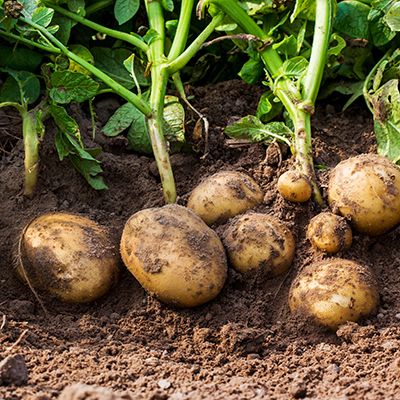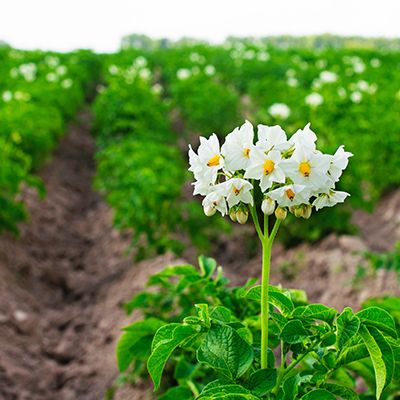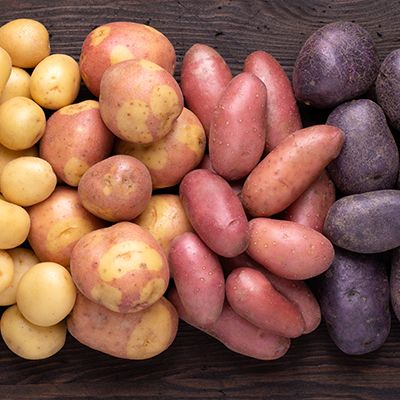


Potatoes
GENERAL INFORMATION
Two pounds of seed potatoes will produce fifty pounds of potatoes for eating. Potatoes need loose, fast-draining soil; tubers become deformed in heavy, poorly drained soil.
PLANTING
The location of potatoes in your garden should be rotated on at least a three year schedule. Add compost to the soil and plant Alfalfa, Beans, Peas, or Peanuts during the interim years (Peanuts can be obtained from bird specialty shops). Potatoes grow best in an acidic soil (pH5.5-6.5); therefore sulfur should be added to the soil in the Bay Area at about 1.5 pounds per 100 square feet and gypsum at a rate of 5 pounds per 100 square feet. A 5-10-5 fertilizer ("Bulb Food") should be applied at planting time and again when the plants are 4 to 6 inches high. Organic grower can substitute cottonseed meal. Potatoes can be planted between November and February.
If you have a heavy clay soil, amend it with two to three inches of Gold Rush or Bumper Crop dug to a depth of 8 to 10 inches or fill a raised bed with nursery mix.
The above ground potato plant is sprawling, bushy and dark green with much-divided leaves somewhat like Tomato plants. Clustered inch-wide flowers are pale blue. Round yellow or greenish fruit is rarely seen.
If using full grown Potatoes, cut Potatoes into chunky pieces with at least two eyes. These pieces should be 1 1/2 to 2 inches square. U.C. Extension recommends that you dust the chunks with sulfur and let them heal overnight. We have found that you can skip the sulfur dusting and then allow several days for the cut surface to dry. Place chunks 4 inches deep, 12 to 18 inches apart and 24 inches between rows. Small whole Potatoes are preferable and are planted the same way.
Potatoes must be "hilled" as they mature. About the time the flowers first appear, you may notice the ground bulging at the base of the plant. Scrape some soil from between the potato plants and form a hill around the base of the plant to keep the potatoes covered. This will have to be repeated several time to prevent the potatoes from getting sunburned (skin turns green and is poisonous) as the potatoes enlarge in the ground.
WATERING
Do not plant if soil is very wet. After top growth appears, give plants a thorough soaking every week or two (so that the soil is moist down to about 12 inches). Potatoes don’t need a lot of water.
DIGGING
Dig early (or new potatoes) when tops begin to flower; dig mature potatoes when tops die down. Dig potatoes carefully using a spading fork to avoid bruises and cuts.
In 40 to 60 days early potatoes will bloom. This is the time to carefully poke around the potato hill by hand to see what you can find. Small potatoes removed at this time are called "new potatoes." Leave enough potatoes to mature to full size.
For the main crop you can either let the first frost kill the vines (spring-planted potatoes) or you kill them yourself by excluding all water or cutting off the tops. Once the vines have died the potatoes need to be left in the ground for two weeks. The skins will toughen and cure to prevent scuffing and bruising. Then you may start harvest.
WEEDING
Weed carefully and thoroughly. There should be no weeds in the potato bed.
STORING
Potatoes are best stored at 36-40 degrees in a dark environment with ventilation and high humidity. Well stored potatoes can last up to six months. Small potatoes (up to 1 1/2 inches in diameter) can be saved and planted next year.